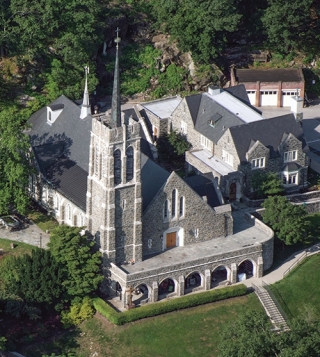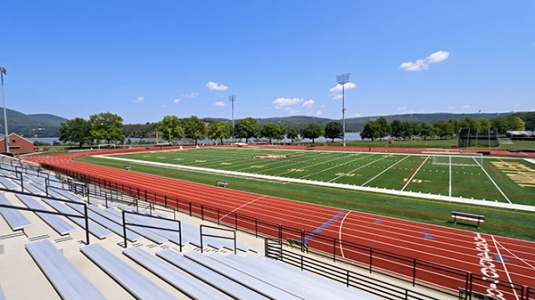In 1971, Colonel William Luebbert ’49, the Director of the Instruction Support Division in the Office of the Dean, wrote: “Good teaching involves much more than a professor standing up and lecturing to a class. It is a leadership challenge that involves developing and managing a total learning environment (system) in which faculty and students work together to achieve specific educational objectives, making full use of whatever technological aids are available and appropriate.” Every graduate has been through USMA’s academic system, yet the technological aids they have used to make it through that system have depended on when they were a cadet. The following passages describe the notable teaching tools used in certain academic departments through the years, with some detailing the tools of today that have replaced them.
Computing
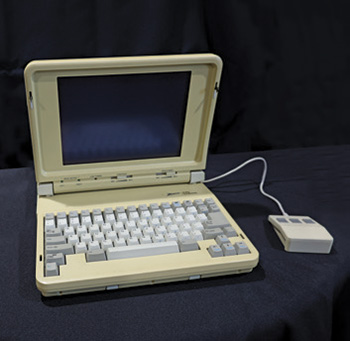
The United States Military Academy entered the computer age in December 1962 with General Order 151. This order established the Academic Computing Center (ACC), the central feature of which was a General Electric 225 digital mainframe computer that was available to all cadets and faculty. The Department of Electricity was the first to employ this computer in coursework (EL483: Digital Computers). In AY 1962-63, the entire Fourth Class was given a GE225 computer assignment as part of their plebe math course. The purpose of the assignment was to compute to seven digits of accuracy the natural logarithm of the numbers 251 through 360. Cadets fed the mainframe with stacks of bubble-filled cards, which provided instructions to the computer. By 1965, the ACC had added two more GE225 systems, which were processing approximately 3,500 cadet programs annually. Three years later, this number jumped to 100,000 programs, and by 1974 USMA mainframes were processing 450,000 programs annually—a nearly 13,000 percent increase in 10 years. In 1980, the Academic Board required computers to be used in 11 core courses, which put a tremendous amount of stress on the (then) antiquated mainframe time-sharing terminals. To compensate, the Academy installed approximately 100 Terak “microcomputers,” configured with 56,000 characters of storage and 8-inch floppy disk drives (cost=$8,935 per unit).
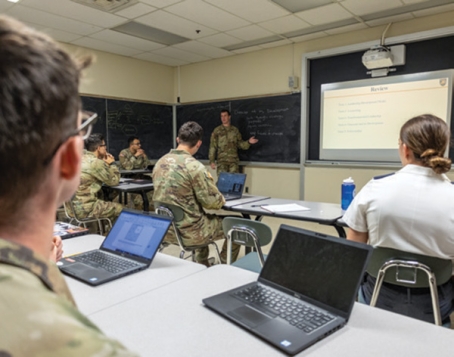
In 1985, Academy Leadership mandated that each cadet and faculty member should have personal networked computers. The Class of 1990 was the first to purchase such computers: the Zenith 248 IBM-PC clone, complete with Microsoft Windows v1.0 and Word v1.0 (cost≈$1,700). At their own expense, some cadets purchased the 24 lb. Zenith Z-180 “laptop” computer, at a cost of nearly $1,000. According to Colonel Tina Hartley ’90, Professor and Mathematics Department Head, “With the introduction of personal computers, the use of computers as part of the core math curriculum really began to take off.” Software on these machines, such as Derive, was used for plotting, symbolically calculating derivatives and integrals, computing limits, and other math tasks. In the fall of 1999, the Math Department, in conjunction with the Economics Department, issued laptops to 32 cadets in the Class of 2002, who were then grouped into separate sections for their Multivariable Calculus and Economics courses. The Class of 2006 was the first class to be issued laptops as their personal computers: a Dell C840 with a Pentium IV processor and 256 megabytes of memory.
Cartography
Drawing was one of the first subjects taught at the Academy. A Teacher of Drawing was hired in 1803. For over a century, drawing included technical engineering products, basic concepts such as perspective, and map making. Cadets of the past spent long hours in the drawing labs mastering ink pens and lettering by hand or with Leroy lettering sets. They also made military maps in the field. Charles Dudley Rhodes, Class of 1889, wrote of a field mapping exercise using a compass, barometer, and drawing materials. Mandatory engineering drawing ceased in the 1970s, but mapping continued for another two decades in EV203: Terrain Analysis. Old Grads may remember using a compass and pace count to produce a map of Trophy Point in the MAPEX lessons. Computer mapping applications started to be taught by the late 1970s, and today’s instructors teach cadets to use ESRI’s ArcGIS Pro and ArcGIS StoryMaps. Global Positioning System technology has also made field mapping much easier and is integrated into many pieces of equipment. Through classes and research projects, cadets gain exposure to the tools of the modern-day cartographer: digital mapping software, the Global Navigation Satellite System, high-resolution satellite and aerial imaging, geospatial analysis, and remote sensing.
Military History

In 1947 Colonel Vincent “Mike” Esposito, Class of 1925, was appointed Professor and Deputy Head of the Military Art and Engineering Department at the Academy. During the next 16 years he established himself as one of the country’s foremost educators in the field of military history. Graduates from the 1950s through the 1970s will remember his West Point Atlas of American Wars as a mainstay on their cadet bookshelves. At the time, it was a revolutionary new concept in teaching the history of military art.
By the mid-1980s, the large hardbound atlases were replaced by spiral-bound books for each epoch of course instruction, making them slightly easier to bring to class. Maps were updated by the Department of History’s cartographer as new information came to light and, as the internet advanced, some maps were placed online as part of the department’s Digital Map Collection. In AY 2013-14, the Academy issued tablets to each cadet enrolled in the History of the Military Art, and in the following year all cadets in the course were using version 1.0 of the West Point History of Warfare. The tablets allow cadets to access digital lesson content, which includes text, imagery, call-out “widgets” and updated interactive maps that feature contextual explanations to accompany time-phased animated movement of units. Edited and compiled by Department of History faculty, the West Point History of Warfare has won several awards for innovation in digital and military history.
Surveying

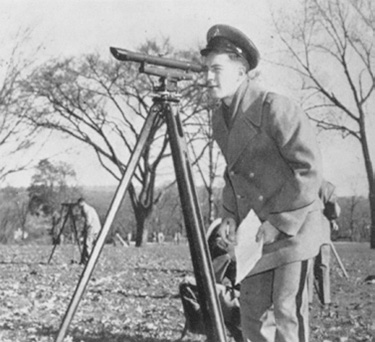
Surveying has been taught at the Academy since 1802 and for decades was taught over multiple years, beginning with mathematical foundations and progressing to equipment and field procedures. The tools available to instructors in the 19th century were essentially a compass, measuring chain, barometer, and theodolite backed up by mathematics. Over time, steel tape replaced chains, and theodolites became the modern engineer’s transit. Total stations, integrating angle and distance measurements, were introduced in the 1970s, and by the 1990s global positioning systems became available for civilian applications and were soon being leveraged by surveyors across the nation.

Today’s robotic total stations can be completely operated using a mobile device, and the Global Navigation Satellite System gives instructors the ability to quickly bring high spatial accuracy to cadet research projects. Practical work in the field has always been part of surveying instruction; cadets surveying on the Plain or Trophy Point is a common subject of old photos. The total station instruments used by cadets today have integrated terrestrial laser scanning (a.k.a. Lidar) that facilitates panoramic 3D imaging of a surveyed area. When combined with traditional surveying fundamentals, the resulting high-resolution 3D geometry can be used to generate accurate models of buildings, trees, topography, and ultimately a digital twin of the real world.
Mathematic Calculations
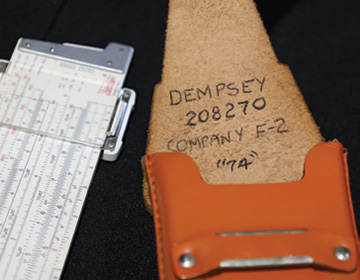
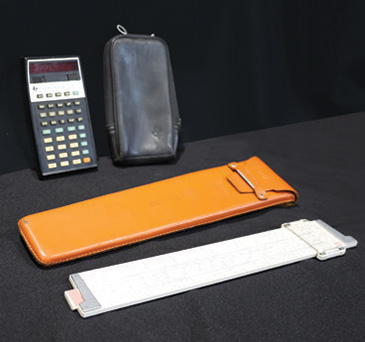
The Department of Mathematics has used several tools to teach math concepts during its more than two centuries of existence. Two of these tools will be very familiar to most grads: either the slide rule or the electronic calculator. According to Colonel Tina Hartley ’92, Professor and Mathematics Department Head, the earliest reference to teaching the slide rule at West Point dates from 1905. “It almost certainly had been used earlier,” notes Hartley, “for by then half of the engineering schools in the United States used slide rules.” She also says that the department once had a Thatcher cylindrical slide rule produced by Keuffel & Esser, model 1741, which dates from the period 1892-1900; this historic artifact was gifted to the Smithsonian in 1958. The amount of time devoted to the slide rule in plebe mathematics varied over the years from five to nine classes (with a maximum of 12 hours). The department also had twenty-seven 8-foot slide rules for demonstration purposes, one in each classroom.

On October 30, 1974, the Applied Science and Engineering Committee and the Basic Sciences Committee recommended that cadets be allowed to use “electronic calculators” beginning in 1975. “From that time forward, the calculator will replace the slide rule as the principal computing device employed by cadets, and cadets will not be required to own a slide rule,” says the committee report. The committee did not specify a brand or model of calculator, but there was only one that fit the specifications: the Texas Instruments model SR-50, which was sold through the mail at $169.95. The first class to be issued these calculators was the Class of 1979, and the model used in math classes varied over the next two decades. In the fall of 1999, plebes were issued the TI-89, a graphing calculator with a computer algebra system; however, with the rise of personal computers, tablets and smart phones, calculators soon went the way of the slide rule.
West Point magazine would like to thank COL Will Wright ’99, MAJ Jordan Laughlin ’11, CPT Victoria Gramlich ’13, CPT Carter Kelly ’13, Dr. Matt O’Banion, and Dr. Jon Malinowski from the Department of Geography and Environmental Engineering; COL Tina R. Hartley ’92 from the Department of Mathematics; COL Bryan Gibby ’93 from the Department of History, and Michael Diaz from the West Point Museum for their assistance with this article.


